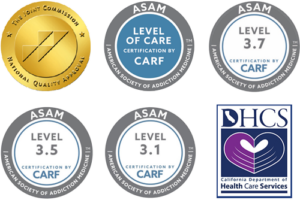Identifying Alcohol Use Disorder: Criteria to Diagnose and Treat AUD
Published on: November 5, 2024 | Updated on: December 3, 2025
Alcohol use disorder (AUD) is a complex and widely recognized medical condition that affects millions of individuals worldwide. Characterized by an inability to control or limit alcohol consumption despite negative consequences, AUD can disrupt daily life, relationships, and overall health. Identifying this disorder involves a careful evaluation of behavioral patterns, emotional symptoms, and physical signs associated with alcohol use. Recognizing the criteria for AUD can be an essential first step in seeking appropriate treatment and support, helping those affected move toward recovery and a healthier life.
What is Alcohol Use Disorder?
Alcohol use disorder (AUD) is a chronic medical condition involving an impaired ability to stop or control alcohol use despite adverse social, occupational, or health consequences. It exists on a spectrum ranging from mild to severe and can develop gradually, often taking years before significantly impacting a person’s daily life and well-being.
AUD is influenced by a combination of genetic, environmental, and psychological factors, making each person’s experience with it unique. Despite common misperceptions, AUD is recognized as a brain disorder by medical and mental health professionals, characterized by changes in brain circuits related to reward, stress, and self-control, which can persist even after stopping alcohol use.
Left untreated, AUD can lead to a range of severe consequences, including liver disease, cardiovascular problems, mental health disorders like depression and anxiety, and even death. However, with the right support, people with AUD can achieve and maintain sobriety.
How is AUD Different from Social or Casual Drinking Habits?
The disorder known as AUD is distinct from casual or social drinking in that it involves compulsive behavior and a significant loss of control over alcohol consumption. Individuals with AUD may find it difficult to abstain, leading to continued drinking despite the negative impacts on their physical health, mental health, and relationships. Common signs of AUD can include an increased tolerance to alcohol, withdrawal symptoms when not drinking, and spending significant time drinking or recovering from its effects. These signs also apply to those who engage in binge drinking, or drinking too much alcohol in short periods of time (five or more drinks per session). Of course, those who drink alcohol socially or in casual settings are at increased risk of developing alcohol use disorder, especially if social drinking takes place over years.
If you find yourself craving alcohol, can’t stop drinking alcohol, or exhibit signs of alcohol dependence, it is critical to seek intervention from licensed health care professionals. With their help, alcohol use can be stopped and the journey to sobriety begins.
Criteria Used in AUD Diagnosis
When identifying alcohol use disorder (AUD), clinicians often refer to the criteria outlined in the DSM-5 (Diagnostic and Statistical Manual of Mental Disorders, Fifth Edition). The DSM-5 lists 11 criteria, and the severity of AUD is classified based on how many of these criteria an individual meets over a 12-month period. The Mental Health Services Administration and the National Institute on Alcohol Abuse and Alcoholism (NIAAA) use these criteria when creating treatment programs, advocating for alcohol abuse patients, and diagnosing individuals with moderate or severe drinking problems.
Here’s a breakdown of these criteria:
- Alcohol intake beyond intentions: Consuming larger amounts or for a longer duration than intended.
- Persistent desire or unsuccessful efforts to cut down: Repeated attempts to reduce alcohol use without success.
- Time spent: A significant amount of time is spent in activities related to drinking, recovering from alcohol’s effects, or acquiring it.
- Cravings: Experiencing strong desires or urges to drink.
- Failure to fulfill major obligations: Alcohol use interferes with responsibilities at work, school, or home.
- Social or interpersonal problems: Continued drinking despite causing or worsening social or interpersonal issues.
- Reduced activities: Giving up or reducing other activities, hobbies, or interests in favor of drinking.
- Hazardous use: Consuming alcohol in situations that are physically dangerous, such as driving or using machinery. Some individuals with advanced dependence may even drink rubbing alcohol, which is extremely dangerous because isopropyl alcohol can lead to severe organ damage, gastrointestinal bleeding, or fatal poisoning.
- Physical or psychological issues: Continued drinking despite knowledge of having persistent or recurrent physical or psychological problems worsened by alcohol.
- Tolerance: Needing more alcohol to achieve the same effects or finding that the usual amount has less effect.
- Withdrawal: Experiencing withdrawal symptoms when alcohol use is reduced or stopped, or using alcohol to avoid withdrawal symptoms.
Severity is classified as follows:
- Mild: Meeting 2-3 criteria
- Moderate: Meeting 4-5 criteria
- Severe: Meeting 6 or more criteria
This framework helps healthcare providers assess whether someone’s drinking behavior qualifies for mental illness such as AUD and the level of intervention needed.
Risk Factors for Developing Alcohol Use Disorder (AUD)
The development of alcohol use disorder (AUD) is influenced by a variety of risk factors, including genetic, environmental, psychological, and social elements. Here are some of the most significant risk factors:
- Genetics and Family History: A family history of alcohol use disorder or other substance use disorders increases the likelihood of developing AUD. Genetics may play a role in how the brain responds to alcohol, influencing susceptibility to addiction.
- Age of First Use: Starting to drink at a young age is associated with a higher risk of developing AUD later in life, as early alcohol exposure can impact brain development and increase dependency risks.
- Mental Health Conditions: People with mental health disorders, such as depression, anxiety, post-traumatic stress disorder (PTSD), or bipolar disorder, are more susceptible to AUD. Alcohol may be used as a form of self-medication, leading to dependency.
- Social and Cultural Factors: Environments where drinking is socially encouraged, such as certain family or community settings, increase the likelihood of developing AUD. Social norms, peer pressure, and cultural attitudes can all influence drinking behaviors.
- Stress and Coping Mechanisms: Chronic stress, often due to difficult life circumstances or high-stress professions, can contribute to AUD risk. People may turn to alcohol as a coping mechanism, especially if healthier coping strategies are not established.
- History of Trauma or Abuse: Trauma, especially if experienced in childhood, is linked to a higher risk of AUD. Individuals who have experienced emotional, physical, or sexual abuse may use alcohol to cope with unresolved trauma.
- Biological Differences: Some people metabolize alcohol differently, which can affect tolerance and increase the risk of developing AUD. For instance, those with a higher tolerance may drink larger amounts, increasing their risk of dependence.
Understanding these risk factors can help in recognizing individuals at greater risk and guide early intervention and prevention efforts.
What Does Drinking Heavily Do to the Body?
Now that we’ve learned what alcohol use disorder is and how it is identified, it is time to discuss the health effects of alcohol abuse.
Heavy alcohol intake over time leads to serious consequences affecting physical, mental, and social well-being:
- Physical Issues: Chronic drinking can cause liver damage (e.g., fatty liver, cirrhosis), cardiovascular problems, weakened immune function, digestive issues, and increased cancer risk (e.g., liver, mouth, and esophagus). It also affects the nervous system, leading to neuropathy and coordination problems.
- Mental Issues: Long-term alcohol use can lead to cognitive decline, memory impairment, and mental health disorders like depression and anxiety. It may also exacerbate conditions like bipolar disorder or lead to alcohol-induced psychosis in severe cases.
- Social Issues: Heavy drinking often disrupts relationships, damages careers, leads to financial strain, and can result in legal problems (e.g., DUIs). It may also contribute to social isolation as relationships become strained due to dependence and associated behaviors.
These effects underscore the importance of seeking help early to mitigate the long-term impacts of heavy drinking.
Dealing With Alcohol Withdrawal Symptoms
Individuals with a history of alcohol or substance abuse, or alcohol dependence may attempt to cut down on drinking or to stop drinking altogether. Unfortunately, there are potential complications, including alcohol withdrawal.
Alcohol withdrawal symptoms vary in intensity, ranging from mild to severe, depending on factors like the duration and quantity of alcohol use. Here’s a brief overview:
- Mild Symptoms: Typically start within a few hours after the last drink and include anxiety, insomnia, headaches, nausea, irritability, sweating, and tremors (shaky hands). These symptoms can be uncomfortable but are generally manageable with support.
- Moderate Symptoms: Develop as withdrawal progresses, often peaking within 24-72 hours. They include more intense sweating, increased heart rate, elevated blood pressure, confusion, mood disturbances, and worsening nausea and vomiting.
- Severe Symptoms: In extreme cases, particularly in individuals with long-term heavy alcohol use, severe withdrawal can lead to life-threatening symptoms such as seizures, hallucinations (seeing or hearing things that aren’t there), and delirium tremens (DTs)—a state of severe confusion, agitation, and fever. Severe symptoms require immediate medical intervention to ensure safety.
Withdrawal experiences vary, so medical supervision is recommended to manage symptoms effectively and prevent complications. Over time, alcohol use disorder can take its toll on physical and mental health as well as legal problems or social issues. Alcohol use disorder treatment is only a phone call away!
Commit to Treatment. Keep Your Job!

Get Help for Alcohol Abuse at Journey Hillside Tarzana
Alcohol addiction is a severe and potentially ruinous condition that can leave harrowing scars and damage upon an individual’s life. However, it’s valuable to remember that recovery is possible and it is necessary to get the right help and support so you can live your life to the fullest. Seeking medical treatment for heavy drinking is a testament to strength, not a sign of weakness, and it’s the first step towards reclaiming control over one’s life.
Are you ready to stop drinking and to take charge of your future? If you are beset with the torture of heavy drinking and alcohol use disorder symptoms, don’t hesitate to reach out to Journey Hillside. We absolutely know and applaud you for the courage it takes to seek help and we’re ready to embrace you and give you the highest level of care and support you deserve. Our team of mental health professionals stands ready to help you identify the warning signs of alcoholism, help limit alcohol cravings during the sobriety journey, and provide support for mental health and physical health complications. Call today to speak to our Admissions Team.





